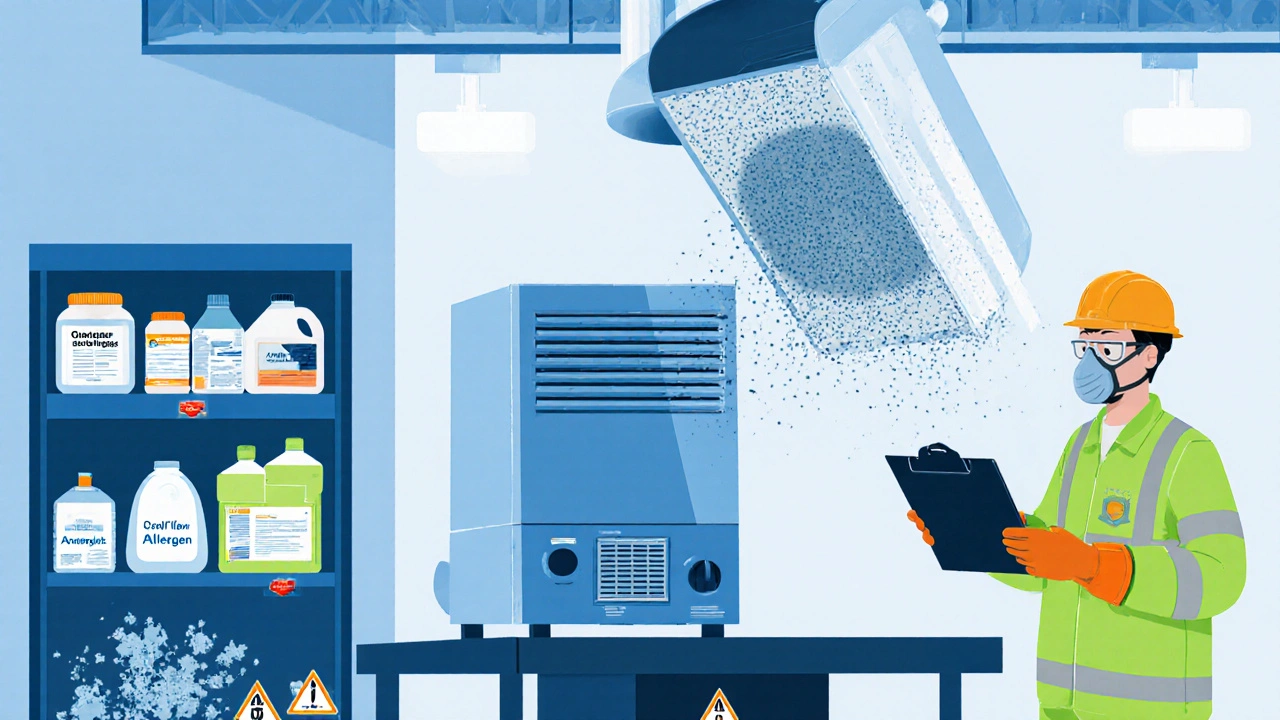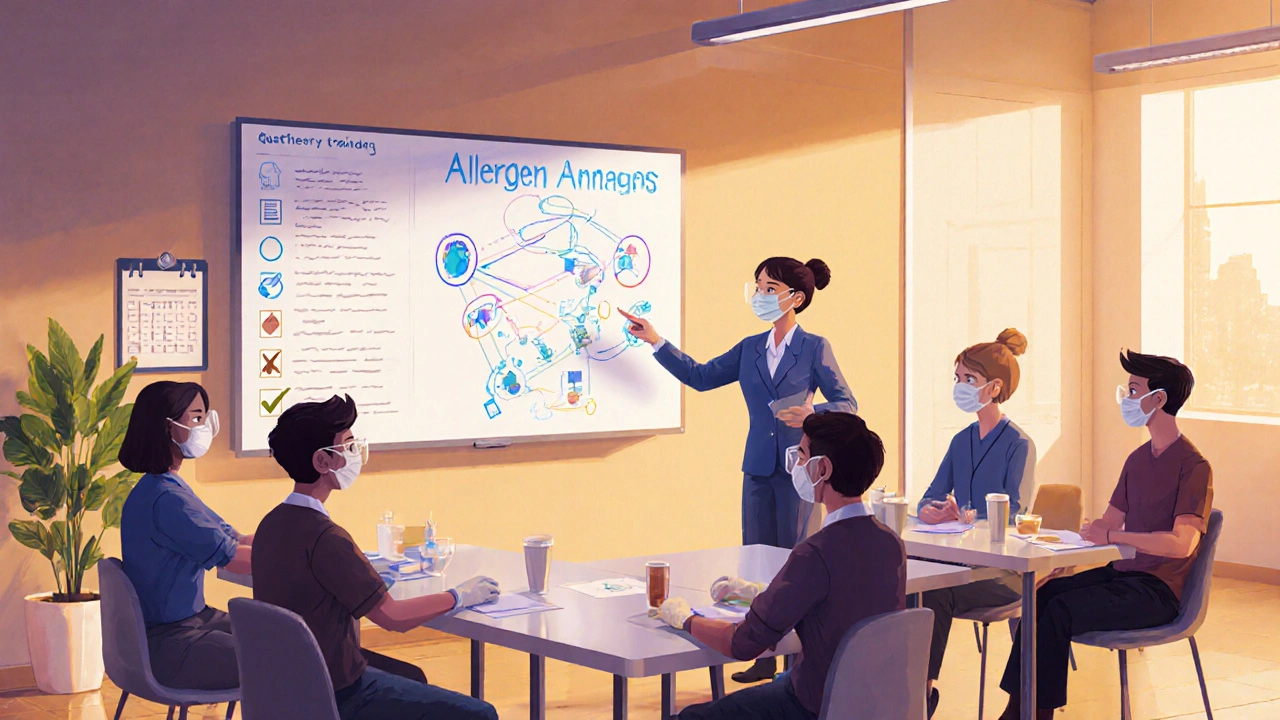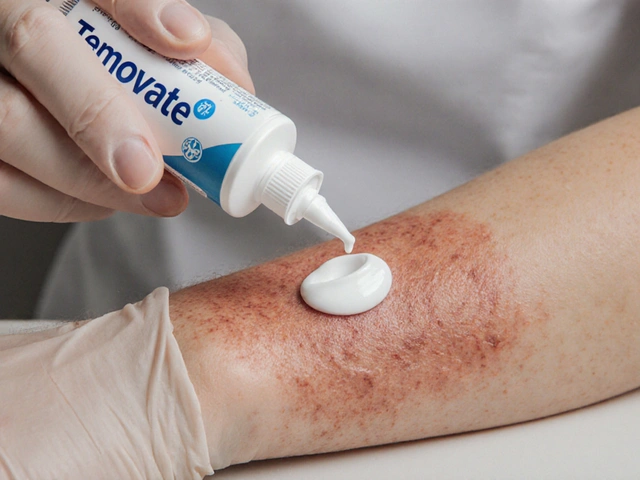Workplace Allergen Risk Assessment Tool
Key Takeaways
- Identify the three most common allergic disorders that show up at work.
- Run a simple risk‑assessment checklist to spot hidden allergens.
- Put a clear medical‑response plan in place before an attack happens.
- Use substitution, ventilation and protective gear to cut exposure.
- Stay compliant with UK health‑and‑safety law and EU directive requirements.
When it comes to Allergic Disorders in the Workplace a range of immune‑driven conditions triggered by substances found in offices, factories or outdoor sites, the costs are more than just a few sick days. Missed shifts, reduced focus and costly medical claims add up fast. The good news? Most problems can be stopped early if you know what to look for and have a plan that blends medical care with practical workplace changes. This guide walks you through the most common issues, how to spot them, what the law expects and which steps actually work on the ground.
Common Workplace Allergic Disorders
Three conditions make up the bulk of allergy‑related complaints at work.
- Allergic rhinitis inflammation of the nasal lining caused by inhaled allergens such as dust, pollen or mold spores. Workers describe sneezing, itchy eyes and a runny nose that linger throughout the shift.
- Contact dermatitis skin inflammation that appears after direct contact with irritants or allergens like cleaning chemicals, latex gloves or metal fasteners. The rash can be red, itchy or blistered and often shows up on hands and forearms.
- Occupational asthma a chronic lung disease triggered by inhalation of substances such as isocyanates, wood dust or animal dander. Symptoms include wheezing, shortness of breath and coughing that worsen on the job and improve on days off.
Comparison of the three main disorders
| Disorder | Typical Triggers | Primary Symptoms | Latency (hours‑days) | First‑line Management |
|---|---|---|---|---|
| Allergic rhinitis | Dust, pollen, mold spores | Sneezing, runny/blocked nose, itchy eyes | Minutes‑hours | Antihistamines, nasal corticosteroids, air filtration |
| Contact dermatitis | Latex, cleaning agents, metal alloys | Red rash, itching, blisters | Hours‑days | Skin barrier creams, avoidance, topical steroids |
| Occupational asthma | Isocyanates, wood dust, animal dander | Wheezing, shortness of breath, cough | Minutes‑hours (sometimes delayed) | Bronchodilators, exposure control, specialist referral |
Recognising Symptoms and Hidden Triggers
Most employees dismiss a runny nose or a dry rash as “just a cold”. The key is to link symptoms to the work environment. Keep a simple log: note the time of day, task performed and any recent cleaning or material handling. If the pattern repeats for several workers, you probably have an allergen any substance that provokes an immune response lurking in the air, on a surface or in a product.
Common hidden sources include:
- Ventilation filters that have collected pollen or mold.
- Latex gloves used in a medical‑supplies room.
- Floor‑waxing chemicals applied after hours.
- Office plants that release volatile organic compounds.

Legal and Regulatory Framework
In the United Kingdom, the Health and Safety at Work Act 1974 obliges employers to protect workers from “any reasonably foreseeable risk”. That includes allergic reactions. The Control of Substances Hazardous to Health (COSHH) Regulations require a risk‑assessment for any substance that can cause respiratory or skin sensitisation.
For sites that operate across the EU, the EU Directive 2000/54/EC regulates protection of workers against risks arising from exposure to biological agents sets minimum exposure limits and mandates health surveillance for identified allergens.
Failure to comply can lead to enforcement notices, hefty fines and, in severe cases, prosecution. Keeping documentation of risk assessments, training records and medical surveillance is therefore not just good practice-it’s a legal safeguard.
Risk Assessment and Health Surveillance
A practical risk‑assessment follows four steps:
- Identify potential allergens substances that can trigger an immune response in each work area.
- Evaluate exposure levels (frequency, duration, concentration).
- Decide on control measures (substitution, engineering, PPE).
- Document findings and assign responsibility for review.
Effective health surveillance ongoing monitoring of workers for early signs of allergy sensitisation complements the assessment. Offer a baseline skin‑prick or IgE test for high‑risk groups, and schedule annual check‑ins with occupational health providers. Early detection of sensitisation can prevent progression to chronic disease.
Immediate Management Strategies
When an employee shows symptoms, act fast:
- Medical response: Provide on‑site first‑aid kits that include antihistamines, inhalers and sterile dressings. Record the incident in a health‑incident log.
- Environmental control: Isolate the source. For example, turn off a dusty machine, increase fresh‑air intake, or replace a cleaning product with a hypo‑allergenic alternative.
- Personal Protective Equipment (PPE): Ensure workers have access to appropriate gloves, masks or eye protection. Use a personal protective equipment gear designed to minimise exposure to hazards that meets BS EN standards.
- Communication: Inform the affected employee about the trigger and advise on avoidance strategies both at work and at home.
Long‑Term Prevention Programs
Prevention works best when it becomes part of the organisation’s culture.
- Substitution: Replace high‑allergen chemicals with low‑sensitisation alternatives. A 2022 UK survey found that firms that swapped solvent‑based cleaners for water‑based ones cut dermatitis cases by 40%.
- Ventilation upgrades: Install high‑efficiency particulate air (HEPA) filters in areas with dust or pollen exposure. Routine filter changes are a cheap but effective control.
- Cleaning protocols: Use dedicated cleaning cloths for each area, store chemicals in sealed containers, and schedule deep‑cleaning during off‑hours to limit worker exposure.
- Training and awareness: Conduct quarterly short talks that cover how to recognise symptoms, safe handling of known allergens, and the proper use of PPE. Real‑world case studies-like the 2021 cheese‑factory outbreak of mold‑related rhinitis-make the message stick.
- Policy documentation: Publish an “Allergy Management Plan” that outlines reporting procedures, medical‑leave options and return‑to‑work criteria. Make it accessible on the intranet and review it annually.

Step‑by‑Step Action Plan for Employers
- Run a baseline audit of all substances and processes for allergenic potential.
- Prioritise high‑risk areas (e.g., laboratories, food‑processing, manufacturing).
- Implement control measures-substitution first, then engineering controls, followed by PPE.
- Set up health‑surveillance enrolment for at‑risk staff.
- Train supervisors and employees on trigger identification and emergency response.
- Document incidents and review control effectiveness every six months.
- Update policies to reflect new findings or regulatory changes.
Checklist for Managers
- Have you identified every potential allergen in your workplace?
- Do you have a written risk‑assessment that includes exposure levels?
- Is personal protective equipment available, maintained and fit‑tested?
- Are employees aware of how to report symptoms?
- Do you have a clear medical‑response protocol, including stocked antihistamines or inhalers?
- Do you conduct regular health‑surveillance for high‑risk roles?
- Are you complying with COSHH and EU Directive 2000/54/EC requirements?
Why effective workplace allergies management matters
Beyond the obvious health benefits, well‑controlled allergy programs boost morale, reduce turnover and protect the bottom line. A 2023 case study from a UK logistics firm showed a 25% drop in sick‑leave costs after introducing a simple allergen‑tracking spreadsheet and replacing scented cleaning agents.
Frequently Asked Questions
What is the difference between allergic rhinitis and a common cold?
Allergic rhinitis lasts as long as you’re exposed to the trigger and usually comes with itchy eyes and clear mucus. A cold fades in a week, often includes fever and thick yellow discharge, and isn’t tied to specific workplace substances.
Do I need a doctor’s note to start health surveillance?
While a formal diagnosis isn’t mandatory, occupational health providers usually ask for a brief medical history. The goal is to establish a baseline, not to diagnose every employee.
How often should PPE be replaced for allergy protection?
Gloves and masks should be inspected before each shift and replaced if they show tears, discoloration, or loss of fit. For high‑allergen environments, schedule a full replacement every 30days regardless of visible wear.
Can I legally require employees to undergo allergy testing?
Testing must be justified by a genuine risk and carried out voluntarily. Under UK law, you can request participation as part of a health‑surveillance program, but you cannot force a medical test that isn’t directly linked to a workplace hazard.
What should I do if an employee has a severe allergic reaction at work?
Call emergency services immediately, administer an epinephrine auto‑injector if trained, and move the person to fresh air. Document the incident, review the trigger, and adjust controls to stop it happening again.






Comments
Hannah Gorman
9/Oct/2025In the grand tapestry of occupational health, allergen management occupies a surprisingly pivotal niche.
Too many managers treat sneezing and skin rashes as mere inconveniences rather than systemic red flags.
The data on lost productivity from untreated occupational asthma alone dwarf most other safety concerns.
Moreover, the legal framework, from COSHH to EU Directive 2000/54/EC, imposes concrete duties that cannot be ignored.
When a company fails to conduct a thorough allergen risk assessment, it not only jeopardizes employee well‑being but also courts costly litigation.
The three most common disorders- allergic rhinitis, contact dermatitis, and occupational asthma- share a common thread of preventability.
Simple measures such as installing HEPA filtration, substituting harsh solvents with water‑based alternatives, and enforcing proper glove protocols can slash incident rates dramatically.
Yet the implementation gap persists because decision‑makers often lack a clear, step‑by‑step roadmap.
First, audit every material in the workspace for known sensitizers, documenting frequency and duration of exposure.
Second, prioritize engineering controls over personal protective equipment, because controls protect the entire workforce uniformly.
Third, establish a health‑surveillance program that includes baseline skin‑prick testing for high‑risk groups.
Fourth, embed an allergy‑management policy into the corporate compliance manual, making it a living document subject to quarterly review.
Training sessions should be concise yet frequent, employing real‑world case studies to cement learning.
Management must also allocate budget for regular filter replacements, as a neglected filter nullifies any other mitigation effort.
Finally, adopt a culture of open reporting where employees feel safe disclosing symptoms without fear of stigma.
Only by marrying regulatory compliance with proactive engineering can organizations truly safeguard their most valuable asset-the people who power their operations.
Tatiana Akimova
9/Oct/2025Rise up, safety officers! Stop treating allergies like a footnote and slap those dust busters into place now! Your crew deserves breathing air that doesn't feel like a chemical warfare zone, so enforce HEPA filters and non‑latex gloves immediately! No more half‑hearted policies-make a bold, zero‑tolerance stance and watch productivity surge! Get moving, because every second you delay is another worker gasping for relief.
Calandra Harris
9/Oct/2025Our workers deserve a fortress against foreign allergens the way our nation shields its borders. The lab of industry must purge all offending chemicals without compromise. Ignorance of the threat is a betrayal of the homeland's health. Only the strongest controls can keep the workplace pure.
Dan Burbank
9/Oct/2025Behold the drama of a workplace that pretends safety while letting dust dance in the ventilation shafts! The elite few who understand the science scoff at half‑measures, yet managers cling to the illusion of compliance. You claim you have a plan, but the reality is a sloppy checklist that crumbles under scrutiny. Let me be clear: without engineering controls the saga ends in chronic coughs and lawsuits. Elevate your standards, install true filtration, and demand accountability from every supervisor. The curtain rises on a healthier future if you dare to rewrite the script.
Anna Marie
9/Oct/2025In light of the detailed guide, I’d like to extend my gratitude for the thoroughness presented. While maintaining a respectful decorum, I encourage peers to adopt the recommended health‑surveillance cadence. Together, we can foster an environment where allergic concerns are addressed with precision. Your cooperation will undoubtedly elevate occupational wellbeing across the board.
Abdulraheem yahya
9/Oct/2025Yo, I was just scrolling through the info and thought, man, this is some solid groundwork. The way it lays out a step‑by‑step audit feels like a roadmap you’d hand to a rookie, but the depth is enough for seasoned safety pros. I appreciate the nod to both engineering controls and the human element, because ignoring the people always backfires. The suggestion to rotate filters regularly is something I’ve seen get skipped in many shops, and that’s a cheap cost that pays big dividends. Also, the emphasis on training with real‑world anecdotes is a smart move-people remember stories better than sterile bullet points. If you layer that with a genuine health‑surveillance schedule, you’re practically future‑proofing the workforce. Bottom line, the guide hits the sweet spot between technical and practical, and that’s what makes it click for anyone trying to keep a clean, safe floor.
Preeti Sharma
9/Oct/2025One could argue that the very notion of “prevention” in workplace allergies is a cultural construct, masking deeper power dynamics. Yet, if we accept that allergens are merely particles, the philosophical debate dissolves into actionable science. Balancing the two perspectives yields a richer strategy: we recognize the symbolic weight of safety while deploying concrete controls. Thus, the guide serves both as a manifesto and a manual, inviting a dual‑lens approach. In the end, the paradox resolves into pragmatic stewardship.
Ted G
9/Oct/2025While the rallying cry sounds fierce, it's worth noting that many of the alleged “dust conspiracies” are actually orchestrated by manufacturers to sell premium filters. The hidden agenda behind the push for HEPA units often aligns with profit motives, not pure altruism. Remember, the chemicals in the air aren’t the only invisible hand shaping our workplace.
Miriam Bresticker
9/Oct/2025Wow, that deep dive really hits the nail on the head, even if some of the phrasing is a bit over the t0p 😅. It’s like you’re mapping the hidden currents of airborne foes, turning invisible threats into a tangible battle plan. The ode to HEPA and surveillance feels almost poetic, reminding us that safety is a living, breathing process 🌬️. Keep the knowledge flowing, because every slight detail can be the difference between a sneeze and a full‑blown crisis. 🙌
Claire Willett
9/Oct/2025Leverage proactive mitigation protocols to optimize workforce resilience.
olivia guerrero
9/Oct/2025Absolutely love how this guide pulls everything together, from risk assessment to employee empowerment, and it does so with crystal‑clear steps, real‑world examples, and practical tools, all wrapped in a friendly tone! The inclusion of health‑surveillance checks, ventilation upgrades, and PPE training creates a holistic safety net, encouraging both management and staff to take ownership, and that’s truly inspiring! Keep sharing these gems, because the more we spread awareness, the healthier our workplaces become, and the brighter the future looks for everyone!
Claire Kondash
9/Oct/2025When I contemplate the paradox you presented, I sense the universe whispering that safety is both an art and a science 🌌. The idea that prevention is a cultural construct invites us to question the underlying narratives that shape policy 📜. Yet, the particles themselves remain indifferent, slipping through cracks and reminding us of the material world’s stubbornness 🌬️. This duality compels us to design interventions that honor both the symbolic and the empirical 🛠️. By integrating rigorous filtration systems with transparent communication, we bridge the gap between myth and method. Moreover, the philosophical lens sharpens our awareness, ensuring that the solutions we adopt are not merely reactive but proactively humane. In practice, this means scheduled filter swaps, continuous training, and an open‑door policy for symptom reporting, all framed within a culture that values dignity. The synergy of these elements creates a resilient ecosystem where workers breathe easy and thrive 🌱. So, let’s celebrate the harmony of thought and action, for it is the keystone of sustainable workplace health. 🌟
Evan Riley
9/Oct/2025Look, if you're still treating workplace allergies as an afterthought, you're courting disaster that the regulators will love to pounce on. The hidden networks of chemical suppliers often hide the true potency of their products, and without rigorous third‑party testing you’re basically walking blind. I’ve seen firms get blindsided when a seemingly harmless solvent sparked a cascade of dermatitis cases. Transparency isn’t optional; it’s a survival tool in a world where corporate secrecy fuels health crises. Speak up, demand full ingredient disclosures, and enforce real‑world controls before the next lawsuit lands on your desk.
Nicole Povelikin
9/Oct/2025Surely you think a single policy will fix everything, but that's just wishful thinking.
SHIVA DALAI
9/Oct/2025In the grand theater of occupational health, the curtain rises upon a meticulous choreography of allergen control, each movement dictated by law and duty. Let the audience-our diligent workforce-breathe the applause of safety.
Vikas Kale
9/Oct/2025From a technical standpoint, implementing a layered defense-engineering controls, administrative protocols, and PPE-constitutes a robust risk mitigation matrix 📊. The efficacy of HEPA filtration can be quantified using MERV ratings, ensuring particle capture efficacy exceeds 99.97% for 0.3 µm aerosols 📈. Moreover, integrating real‑time air quality sensors into the building management system provides actionable data for continuous improvement 🌐. Remember, compliance is not a checkbox; it’s an evolving ecosystem that thrives on data‑driven decisions.
Deidra Moran
9/Oct/2025The narrative you present conveniently overlooks the covert influence of corporate lobbying on regulatory standards, a reality that shapes what is deemed “acceptable” in our industry. By accepting the status quo, we unwittingly endorse an agenda that prioritizes profit over genuine worker safety. A critical examination reveals that true protection demands independent verification beyond the industry’s self‑regulation.
Zuber Zuberkhan
9/Oct/2025Let’s channel our collective energy into building bridges between management and staff, forging solutions that everyone can rally behind. By embracing both assertive action and thoughtful dialogue, we can implement stronger ventilation and safer chemicals without alienating any party. Optimism paired with decisive steps will transform workplaces into havens of health and productivity. Together, we’ll turn these guidelines into lived reality, benefitting every worker.